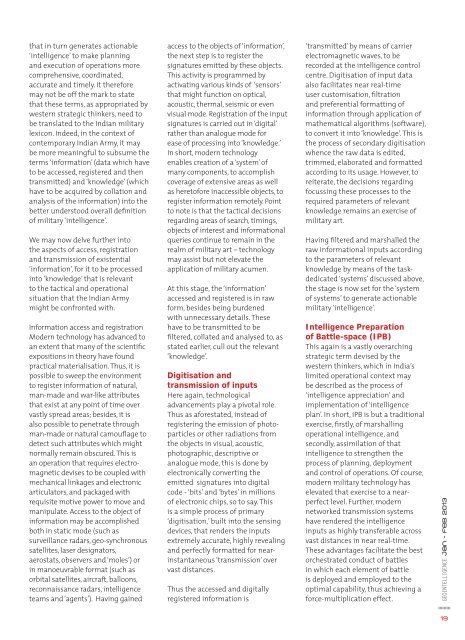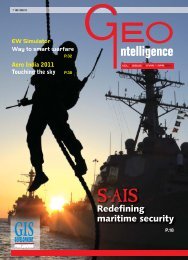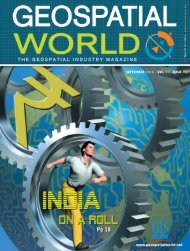Download PDF - Geospatialworld.net
Download PDF - Geospatialworld.net
Download PDF - Geospatialworld.net
You also want an ePaper? Increase the reach of your titles
YUMPU automatically turns print PDFs into web optimized ePapers that Google loves.
that in turn generates actionable‘intelligence’ to make planningand execution of operations morecomprehensive, coordinated,accurate and timely. It thereforemay not be off the mark to statethat these terms, as appropriated bywestern strategic thinkers, need tobe translated to the Indian militarylexicon. Indeed, in the context ofcontemporary Indian Army, it maybe more meaningful to subsume theterms ‘information’ (data which haveto be accessed, registered and thentransmitted) and ‘knowledge’ (whichhave to be acquired by collation andanalysis of the information) into thebetter understood overall definitionof military ‘intelligence’.We may now delve further intothe aspects of access, registrationand transmission of existential‘information’, for it to be processedinto ‘knowledge’ that is relevantto the tactical and operationalsituation that the Indian Armymight be confronted with.Information access and registrationModern technology has advanced toan extent that many of the scientificexpositions in theory have foundpractical materialisation. Thus, it ispossible to sweep the environmentto register information of natural,man-made and war-like attributesthat exist at any point of time overvastly spread areas; besides, it isalso possible to pe<strong>net</strong>rate throughman-made or natural camouflage todetect such attributes which mightnormally remain obscured. This isan operation that requires electromag<strong>net</strong>icdevises to be coupled withmechanical linkages and electronicarticulators, and packaged withrequisite motive power to move andmanipulate. Access to the object ofinformation may be accomplishedboth in static mode (such assurveillance radars, geo-synchronoussatellites, laser designators,aerostats, observers and ‘moles’) orin manoeuvrable format (such asorbital satellites, aircraft, balloons,reconnaissance radars, intelligenceteams and ‘agents’). Having gainedaccess to the objects of ‘information’,the next step is to register thesignatures emitted by these objects.This activity is programmed byactivating various kinds of ‘sensors’that might function on optical,acoustic, thermal, seismic or evenvisual mode. Registration of the inputsignatures is carried out in ‘digital’rather than analogue mode forease of processing into ‘knowledge.’In short, modern technologyenables creation of a ‘system’ ofmany components, to accomplishcoverage of extensive areas as wellas heretofore inaccessible objects, toregister information remotely. Pointto note is that the tactical decisionsregarding areas of search, timings,objects of interest and informationalqueries continue to remain in therealm of military art – technologymay assist but not elevate theapplication of military acumen.At this stage, the ‘information’accessed and registered is in rawform, besides being burdenedwith unnecessary details. Thesehave to be transmitted to befiltered, collated and analysed to, asstated earlier, cull out the relevant‘knowledge’.Digitisation andtransmission of inputsHere again, technologicaladvancements play a pivotal role.Thus as aforestated, instead ofregistering the emission of photoparticlesor other radiations fromthe objects in visual, acoustic,photographic, descriptive oranalogue mode, this is done byelectronically converting theemitted signatures into digitalcode - ‘bits’ and ‘bytes’ in millionsof electronic chips, so to say. Thisis a simple process of primary‘digitisation,’ built into the sensingdevices, that renders the inputsextremely accurate, highly revealingand perfectly formatted for nearinstantaneous‘transmission’ overvast distances.Thus the accessed and digitallyregistered information is‘transmitted’ by means of carrierelectromag<strong>net</strong>ic waves, to berecorded at the intelligence controlcentre. Digitisation of input dataalso facilitates near real-timeuser customisation, filtrationand preferential formatting ofinformation through application ofmathematical algorithms (software),to convert it into ‘knowledge’. This isthe process of secondary digitisationwhence the raw data is edited,trimmed, elaborated and formattedaccording to its usage. However, toreiterate, the decisions regardingfocussing these processes to therequired parameters of relevantknowledge remains an exercise ofmilitary art.Having filtered and marshalled theraw informational inputs accordingto the parameters of relevantknowledge by means of the taskdedicated‘systems’ discussed above,the stage is now set for the ‘systemof systems’ to generate actionablemilitary ‘intelligence’.Intelligence Preparationof Battle-space (IPB)This again is a vastly overarchingstrategic term devised by thewestern thinkers, which in India’slimited operational context maybe described as the process of‘intelligence appreciation’ andimplementation of ‘intelligenceplan’. In short, IPB is but a traditionalexercise, firstly, of marshallingoperational intelligence, andsecondly, assimilation of thatintelligence to strengthen theprocess of planning, deploymentand control of operations. Of course,modern military technology haselevated that exercise to a nearperfectlevel. Further, modern<strong>net</strong>worked transmission systemshave rendered the intelligenceinputs as highly transferable acrossvast distances in near real-time.These advantages facilitate the bestorchestrated conduct of battlesin which each element of battleis deployed and employed to theoptimal capability, thus achieving aforce-multiplication effect.GEOINTELLIGENCE jan - feb 201319





